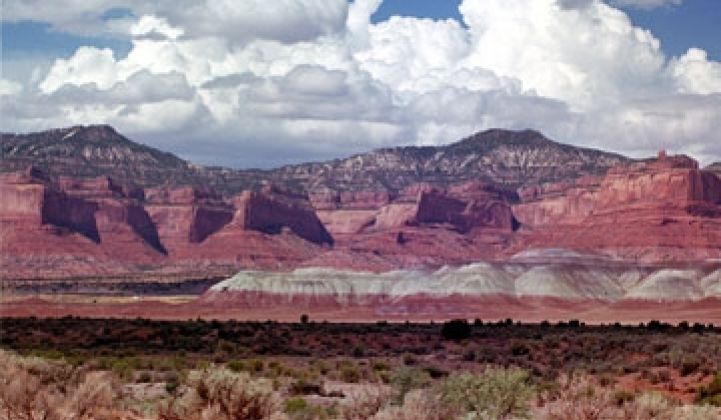It's a seventeen-square-mile parcel of dry, windswept land in the Navajo Nation that isn't near very much.
Unless you count the transmission lines connecting it to a nearby coal-burning power plant in Arizona.
Renewable developer NativeOne -- along with the LeChee Chapter of the Navajo Nation and a Navajo family -- have embarked on a plan to build a solar power plant on that parcel of real estate, and in the process underscore the growing opportunity for erecting alternative energy installations on Native American lands across the country. Under the right circumstances, these deals can lead to lower prices for developers, and jobs, royalties and revenue for the tribes.
"We want to make sure that whatever we build creates jobs and income and is eventually owned by the tribe," said Don Lyons, CEO of NativeOne Financial Holdings, the parent company, and a member of the Morongo band of Mission Indians.
In Alaska, Laurus Energy is working with the Cook Inlet Region Inc., (CIRI) a Native American corporation, to build an underground coal gasification facility in Alaska. CIRI also has invested in wind farms, a geothermal project and the Westly Group, the VC firm headed up by Steve Westly.
The Southern Ute Indian Tribe owns a piece of Solix Biofuels, a Colorado startup that wants to produce diesel from algae. Elster, meanwhile, recently signed a deal to install smart grid equipment and meters in the Navajo nation.
Although Native Americans only constitute about 1.4 percent of the U.S. population, national tribes hold over 55.7 million acres of land. Twelve reservations are larger than Rhode Island and nine are larger than Delaware, according to Scott Eskwitt, a director at NativeOne. The Navajo alone collectively own reservation lands that rival West Virginia in size.
"Renewable energy development creates value in land that can either no longer be used for agricultural purposes or was previously worthless," Eskwitt said. "In the 1800s, the government forced Native Americans onto lands that at the time were thought to be without value. Then they ran the national power grid across those lands. Add in the sun and the wind, and renewable energy becomes the best and highest use of the property."
The population boom in the West that has taken place over the last thirty years has resulted in many of these lands becoming closer in proximity to exurbs of sprawling metropolitan hubs like Las Vegas and Phoenix, along with the transmission lines that serve them. The transmission lines for the Shandiin project that are being pursued by NativeOne, in fact, already cross the tribe's property. NativeOne also recently signed a deal that gives it exclusive rights to build wind farms on 1,280 acres of land owned by the Yakama Nation in Washington state. The company is also talking with other tribes about subjects like biomass, solar thermal, wind and other projects.
But perhaps more importantly, Native American tribes can effectively give developers a way to circumvent the regulations and paperwork that surround projects sited on federal or state land. Bureaucracy has become one of the most frequently heard complaints among solar developers. Momentum to build wind and solar farms in the Mojave ended after U.S. Senator Dianne Feinstein proposed setting aside a million acres in the area to be part of a national monument. BrightSource Energy earlier this year had to pare back the size of the Ivanpah solar thermal power plant in California to satisfy environmental concerns.
To get around some of California's regulations, solar developers are building power plants to serve California consumers in more business-friendly Arizona and are even studying ways to build them in even less regulatory-minded Mexico.
Federally recognized tribes are sovereign nations. Once a tribal council makes a decision, the administrative and permitting process is relatively quick and smooth, according to Eskwitt. Non-native landholders and interest groups do not have to be consulted and can't halt projects. NativeOne is 51% owned by Native Americans, which allows it to qualify for minority-owned business contracts.
Tribes, of course, have their own internal political battles, and some developers have told Greentech Media that they strictly avoid doing business with them because of that. Additionally, many tribal lands remain far from easy grid access.
"It can be exceedingly difficult," admits Eskwitt. The company's Native American ownership, however, allows it to cut through some of this, he added.
Still, favorable circumstances exist which can get around these problems and keep prices low. The land for the Shandiin project, for instance, is actually held by a single family under what is known as a Range Management Unit. Although originally designated as grazing land, NativeOne and the LeChee chapter managed to get the use designation changed.
In the Shandiin project, the LeChee and the family will not charge for the land, a boon for the developer. Instead, these groups will be compensated out of revenue from the sale of electricity once the plant is up and running. After NativeOne and the investors have amortized the depreciation and taken advantage of the tax credits, they will then transfer the ownership of the plant to the LeChee, who will continue to operate it and maintain it.
Other tribes also believe alternative energy has a brighter future than tourism and casinos, particularly with many states tinkering with ways to expand legalized gambling. Many of the construction jobs on NativeOne's projects will go to tribe members.



